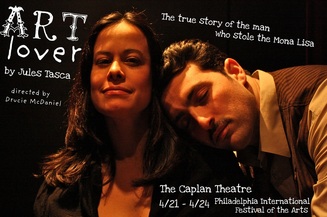
In fact, the Mona Lisa has inspired many other works of art since da Vinci painted her in 1503 (or ‘04). She’s been the object of speculation, obsession and fascination since her creation. And, in Paris during the time that provided the inspiration for this year’s Philadelphia International Festival of the Arts (1911-1920) she disappeared for two years, spirited out of the Louvre by a worker under his coat. Authorities were stumped, and even arrested French poet Guillaume Apollinaire, who tried to implicate Pablo Picasso, who was also brought in for questioning, but both were later exonerated (thank you, Wikipedia!)
The theft of the world’s most famous painting, on August 22, 1911, continues to inspire: there are three events at PIFA that touch upon or revolve around her kidnapping: on April 9, Astral Artists presented “Who Stole The Mona Lisa?,” a multimedia experience; now running at the Arden Theatre is Rogelio Martinez’s “Wanamaker’s Pursuit,” (through May 22) in which the denizens of Paris’s art scene in the Belle Epoch ponder her theft; and Jules Tasca has written a play about the man who took her home with him, “Art Lover,” at the Caplan Studio, at the University of the Arts, 211 Broad Street, April 21-24. Tickets are $5-$10.

When PIFA was in its formative stages, he attended preliminary meetings, and found that the period they were focusing on was when the play he wanted to write was set. He wrote it, submitted it to the festival and it was accepted.
“I’m producing the play myself,” he said. “It takes over your whole life.” I know, Jules. I know. “But it’s a fun experience. We’ve got the flyers, the postcards, we go up April 21st for 6 performances. We have the theater for a week. We’re all hoping to break even.” (Godspeed, brave playwright/ producer! Been there…done that…have the props in my storage unit.)

There hadn’t been a play written about art thief, and as Tasca researched it, he went over the transcripts of Vincenzo Peruggia’s trial. The reason generally given for the theft is either that the Peruggia was a patriot who wanted the painting returned to Italy, or that he may have been part of a plan to sell copies of the missing painting as the original. Tasca found another motivation for the thief.
“The thing that really made it go,” he said. “Was the fact that he [Peruggia] took up with a streetwalker, and according to the trial transcript, she had a striking resemblance to the Mona Lisa. It’s the Madonna/whore syndrome, literally. He had the Mona Lisa when she wasn’t there. When he was there, he was screwing this girl who looked like the Mona Lisa…the idea and the real. He’s living this fantasy life for almost two years. If this was just a play about the art theft, it would have been interesting; this gave it a whole new layer.”
Tasca went to work and said the play progressed quickly. “It wrote itself in a sense,” he said. He showed the script to director Drucie McDaniel, and they cast actors Alex Mandell and Illiana Hubbard as Peruggia and the streetwalker, Mathilde.

From 1911-1913, Peruggia kept the painting hidden in his Paris apartment, then returned to Italy with it. He was finally arrested in Florence, and was hailed as a patriot by many of his fellow Italians, for returning the painting to its “homeland.”
After its recovery, the painting was exhibited in Italy before being returned to the Louvre. Peruggia served six months in jail for the theft.
The Mona Lisa continues to reside (and inspire) at the Louvre.
Ed note: Kathleen Warnock received financial compensation for this post from PIFA (Philadelphia International Festival of the Arts).
 RSS Feed
RSS Feed
